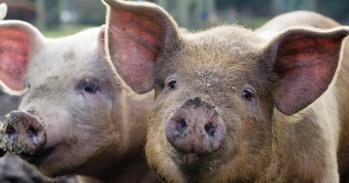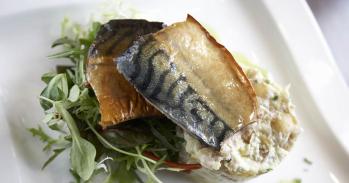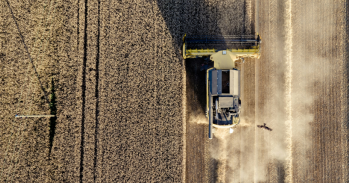A passion for fungi led Cambridge mycologist Dr Dillon Weston to ever-more inventive means of trapping fungal spores, even from the open window of an airship on its maiden flight in the first half of the 20th century.
A passion for fungi led Cambridge mycologist Dr Dillon Weston to ever-more inventive means of trapping fungal spores, even from the open window of an airship on its maiden flight in the first half of the 20th century.
Newspaper coverage of the time showed that the scientist who chased invisible diseases captured both tiny spores and the imagination of the public
Ruth Horry
On a July day in 1930, British Airship R100 took to the sky from a Bedfordshire airfield on its first transatlantic flight. As it made its way across the Atlantic Ocean, 2,000ft above sea-level, a window opened and Squadron Leader Booth, wearing a pair of rubber gloves, leaned out. In his hand was a Petri dish.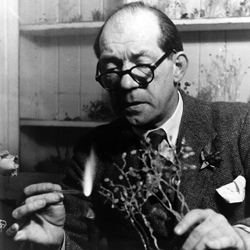
Below, on the HMS Ausonia, Cambridge mycologist Dr W.A.R. Dillon Weston watched through the porthole of his cabin. It was his Petri dish – in reality, a spore trap, capturing minute particles released from fungi and carried with the wind – that Booth was holding. “The thrill of the airship excited Dillon Weston as much as the thrill of spore chasing,” explained Dr Ruth Horry from the Department of History and Philosophy of Science, who has been researching his story.
This adventure was set against the backdrop of what Picture Post magazine declared a “man-versus-fungi battle”. Wheat rust had wiped out enormous areas of American and Canadian wheat production and coffee rust had destroyed entire plantations in Ceylon. “Those who know most about them are still frightened of the fungi,” said Picture Post.
Dillon Weston and fellow scientists suspected that one route of spore transmission over long distances was through air currents. But how to test this? “He was carrying out his studies in the 1920s and 1930s when research methodology was in its infancy,” said Horry. “Where his creativity literally took off was in realising that to test the atmosphere for spores he had to invent ways to catch them, using aeroplanes and home-made Vaseline spore traps.”
“At first sight it may appear ludicrous that the aeroplane can have any significance in biologic research. Is it, however, absurd?” said Dillon Weston in 1929. Intrigued by the finding of some of his American colleagues that aircraft-borne spore traps could detect spores at 11,000 feet, Dillon Weston persuaded friends in the Cambridge University Air Squadron to fly over the Cambridgeshire countryside at various heights. Although his results were as much about devising the perfect spore trap as about the spores themselves, he concluded that the air was a viable medium for spores to be transported.
“Devastating yet invisible plant diseases were an important enemy to conquer and new aviation technologies were vital in winning the war against them,” said Horry. “Newspaper coverage of the time showed that the scientist who chased invisible diseases captured both tiny spores and the imagination of the public: ‘Disease germs two miles up – flying scientists chase them’ declared one newspaper.”
But it was Dillon Weston’s next foray into the skies that is perhaps the most fascinating as a milestone in mycology, and the history of science, as British Airship R100 took off with his spore traps aboard. The mycologist had in effect moved his laboratory from the earth into the skies above.
“He watched the airship through the porthole of his cabin, with his spore traps 2,000 ft skywards in the hands of the airship’s Captain,” said Horry. Using official flight papers, telegrams, family letters and newspaper reports, Horry has pieced together not only the events of the day, but also how he managed to ‘piggy-back’ such a high-profile experimental flight with his homemade spore traps.
“The airship project had been foundering through technical setbacks and lack of financial support,” she explained. “Sensing an opportunity, the Air Ministry co-opted Dillon Weston’s spore experiment as a means of adding scientific legitimation to the scheme – it helped to sell an unknown airship to a public suffering from ‘airship fatigue’.”
Dillon Weston’s results from the airship experiment were never published, as it became impossible to repeat this initial trial. Two months after the R100 completed her journey, the British Air Ministry’s airship R101 tragically crashed on its first voyage to India, claiming the lives of all on board. Less than a year after the spore experiment, the airship scheme was terminated. 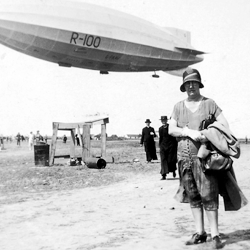
Although the experiment was never to be repeated, Horry believes that it is representative of a wider concept in science: the idea of ‘piggy-backing’ small-scale experiments on larger scale projects. “Dillon Weston’s scientific work aboard R100 was a small-scale experiment that required complex technologies to reach its location of study,” she said.
“As fascinating as this story of airships and fungi is, its wider value has been in revealing that historians need a better understanding of scientific experiments that are dependent upon large-scale, external technological programmes for their existence.” She points towards astrobiology experiments to study the origins of extraterrestrial life on board early NASA space flights as a more recent example of piggy-back science.
Horry added: “The spore experiment’s subsequent disappearance from view acts as an indicator that other now-forgotten examples of piggyback science could have been attached to large scale 20th-century technologies. It may just require us to don our historical rubber gloves, take to the air and chase them down.”
Inset image – top: Dillon Weston. Credit: John S Murray
Inset image – middle: R100 at mast in Canada. Credit: Ruth Horry
Inset image – bottom: Puffballs - Lycoperdon. Credit: Whipple Museum of the History of Science
Fungi formed from glass
At the same time as he saw the devastation to crops and financial ruin that fungi could cause, Dr Dillon Weston was mesmerised by their splendour. “People thought fungi repulsive, and I wanted to show how beautiful they can be,” he wrote at the time.
Take Phytophthora infestans, the potato blight pathogen, responsible for destroying potato crops across Europe in the 1840s, contributing to mass starvation and the Great Irish Famine. 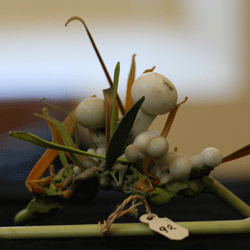 Dillon Weston used the pathogen as the basis of an intricate glass model the height of a hand’s span, 400-times larger than the actual organism. Its delicate tendrils stretch upwards, crisscrossing each other in a complex and fragile array of strands topped by tiny oval heads crammed with spores. It is beautiful, but this beauty belies the pathogen’s legacy of death.
Dillon Weston used the pathogen as the basis of an intricate glass model the height of a hand’s span, 400-times larger than the actual organism. Its delicate tendrils stretch upwards, crisscrossing each other in a complex and fragile array of strands topped by tiny oval heads crammed with spores. It is beautiful, but this beauty belies the pathogen’s legacy of death.
“He crafted some of his models in microscopic detail, showing fungal processes like spore formation and release,” explained Dr Ruth Horry from the Department of History and Philosophy of Science, who has been researching the life stories of objects that become part of museum collections.
His legacy of over 90 models is now housed in the Whipple Museum of the History of Science in Cambridge. Many are impeccable reproductions in microscopic detail of fungi such as those responsible for the mould commonly seen on bread, the fungus that sweetens wine and the leaf spot found on sugar beet; others are life-sized interpretations of woodland fungi, brightly coloured in russet and ochre; and all would have been an invaluable teaching aid for his students who rarely had access to three-dimensional representations of the organisms they were studying.
The text in this work is licensed under a Creative Commons Licence. If you use this content on your site please link back to this page. For image rights, please see the credits associated with each individual image.



